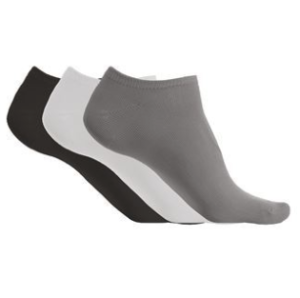From track and field athletes to mountain climbers, people from all walks of life depend upon socks to provide comfort, support and warmth necessary to achieve their goals and realise their dreams. Even ordinary office workers who must pound the pavement on their daily commute or tread the boards navigating their workplace is no stranger to the difference that a pair of good-quality socks makes to their lives.

Sock Materials
With that in mind, it’s important to remember that not all socks are created equal. There are a variety of different materials which can be used to manufacture these small but essential elements of your wardrobe, and depending on how often you plan to wear them and in what context, there are likely to be huge discrepancies in the socks that are best suited to your purpose. Here’s a quick rundown of the various materials from which socks can be created:
Cotton
As the most affordable material with an inherently natural feel, cotton is undoubtedly the most popular choice for manufacturing socks. It’s ideal for casual or office wear, but less suited to sports socks due to its propensity to retain moisture.
Nylon
Nylon is generally a secondary material used in the construction of an article of clothing, blended in with another, and normally constitutes between 20% and 50% of the sock’s overall composition. As a long-lasting and robust fabric, it can add support, whilst it also offers quick-drying properties too.
Elastane, lyrca or spandex
As incredibly stretchy materials, these three can add elasticity and give to a sock to allow for a better fit to the foot. Despite only contributing a small percentage to the sock’s overall fabric makeup, these can improve comfort, size and shape even after repeated usage.
Acrylic
Acrylic is a more affordable alternative to Merino wool, offering similar warmth and superb drying qualities at a fraction of the price. It’s also fairly versatile and provides comfortable cushioning to the foot inside a shoe or boot, making it a good choice for walkers.
Climayarn
A blend of Merino wool with the thermoplastic polymer polypropylene, Climayarn has been specifically engineered to regulate temperature for use in extreme conditions. This means that it will retain warmth in colder climates and preventing overheating in warmer ones.
Coolmax
Coolmax is a polyester fabric that has also been developed with skin temperature and moisture management in mind. By drawing perspiration towards the fibres, it can effectively control hydration and improve insulation on colder days, while still maintaining air penetration to a strong degree.
Modal
Manufactured by spinning reconstituted cellulose fibres, Modal is soft to the touch, silky to look at it and 50% more water-absorbent than cotton, making it an ideal choice for nightwear and underwear. It’s also highly resistant to colour fading and shrinkage, even after multiple washes.
Tactel
Manufactured by DuPont, Tactel is a highly functional combination of microfibres which delivers long-lasting life and excellent colour retention, without sacrificing a soft texture or a pleasing aesthetic.
Thermolite
Thermolite is the ideal material for use in socks that are designed for wet conditions, since its large surface area attracts moisture away from the skin and facilitates fast evaporation. Comfortable and warm without being heavy, it uses hollow-core fibre technology to trap in air and boost insulation.
Bamboo
An unlikely source of sock material, bamboo is being hailed as the eco-friendly solution to 21st century clothing. It’s highly breathable and keeps the skin cool, while absorbing moisture and releasing it efficiently into the air. It’s also naturally antibacterial, bestowing another green benefit on the wearer.

Picking the right socks for you
The main thing to consider when selecting which socks to opt for is the purpose and occasion in which they will be employed. If a sporty sock is required, breathability and moisture control are likely to be paramount concerns, meaning a sock constructed from nylon, bamboo or Coolmax might be preferable. For socks designed for hiking, hillwalking and other extreme environments, a material which regulates temperatures and keeps out moisture might be best, such as acrylic, Climayarn or Thermolite. Meanwhile everyday socks for the home, office or beyond should prioritise comfort and longevity, so cotton or Modal might be the best choices.
Still unsure which sock material is best suited to your circumstances? Not to worry. Our experienced team are always on hand to answer any questions you might have and dispense any advice you might need. What’s more, our extensive range of personalised socks come in a variety of sizes and styles, meaning there’s guaranteed to be a sock in our catalogue that meets your unique needs. Browse online or get in touch with us today and we’ll have you paired up in next to no time.